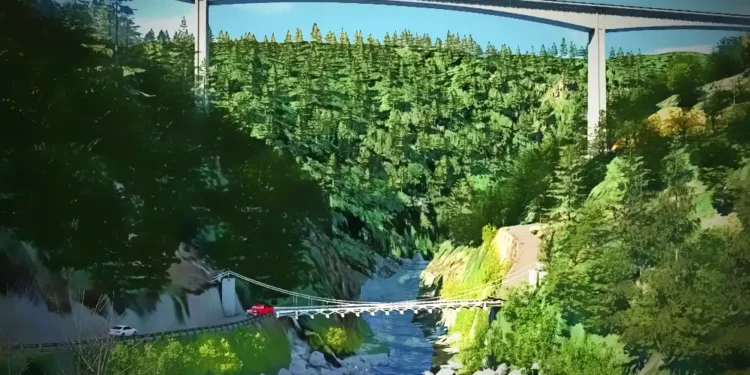By Cris Alarcon, InEDC Writer. (May 2, 2025)
PLACERVILLE, Calif. — Construction on the new Mosquito Road Bridge in El Dorado County has reached a significant milestone, with the project now 87% complete in terms of working days, according to county officials. The bridge, designed to replace the aging 1939 timber suspension bridge, is progressing steadily, with completion anticipated in March 2026.
Brian Franklin, El Dorado County’s senior civil engineer, noted that while the project is approximately 87% complete in terms of working days, it is around 70% complete in terms of budget. The $93 million project remains fully funded through the federal Highway Bridge Program.
The new bridge will span approximately 1,200 feet over the South Fork of the American River, featuring two main piers each rising over 230 feet from their footings. Construction employs a balanced cantilever method, allowing crews to build the bridge segment by segment outward from the piers. This technique is essential for spanning the deep and rugged gorge.
Recent construction efforts have focused on installing and pouring the upper stem and diaphragm concrete at both Pier 2 and Pier 3. On April 23, crews successfully placed Pier 3’s upper diaphragm concrete, with Pier 2 scheduled for final placement on May 2. These developments mark the transition into assembling the bridge’s form travelers, movable scaffolding that facilitates the construction of the bridge’s superstructure segments.
To accommodate the next phase of construction and ensure public safety, El Dorado County has announced a 10-week road closure on Mosquito Road at the project gates from May 27 to August 3, 2025. During this period, crews will perform drainage work, monthly crane inspections, and multiple concrete pours for the bridge’s north superstructure segments. Traffic will be rerouted via Rock Creek Road, with intermittent closures and equipment staging expected throughout the summer.
The existing Mosquito Bridge, a narrow one-lane structure with a 5-ton weight limit, has long been a concern for residents and emergency services. The new bridge will provide a modern, two-lane crossing with full load capacity, enhancing access for the Mosquito and Swansboro communities. El Dorado County plans to preserve the historic bridge for pedestrian and bicycle access after the new span opens, maintaining a physical link to the region’s Gold Rush–era infrastructure.
The historic Mosquito Road Bridge, also known as the Mosquito Bridge, is one of El Dorado County’s most iconic and historically significant structures. Built in 1939, the bridge is a single-lane timber and steel suspension bridge that spans the South Fork of the American River, connecting the communities of Placerville and Swansboro via the steep and winding Mosquito Road.
Historic Background
The bridge was constructed as a New Deal–era public works project, likely funded under federal programs such as the Works Progress Administration (WPA). At the time, it was an engineering marvel, especially given the remote and rugged terrain it traversed. The bridge hangs suspended across a deep canyon, with towers anchored directly into the rocky hillsides and cables supporting a narrow wooden deck.
Originally built to accommodate horse-drawn wagons and early automobiles, the bridge quickly became a vital transportation link for residents in the Mosquito and Swansboro areas, especially after the post-WWII rural expansion.
Engineering and Design
-
Type: Suspension bridge
-
Length: Approximately 241 feet
-
Width: Narrow single lane
-
Weight limit: Historically capped at 5 tons
-
Deck material: Wood planks
-
Supports: Cables anchored to hillside concrete abutments
Its narrow width, sharp approaches, and wooden deck have long posed safety and accessibility concerns, especially for emergency vehicles. Despite its limitations, the bridge has endured decades of service and remains a symbol of rural ingenuity and endurance.
Cultural and Community Significance
For locals, the Mosquito Bridge is more than just a road—it represents a lifeline to essential services, especially for residents of Swansboro, an isolated mountain community. During wildfires, storms, or other emergencies, it has served as a crucial evacuation route. At the same time, it has inspired awe and caution among travelers for its dramatic views and precarious drop-offs.
Many residents have shared stories of crossing the bridge in fog, snow, or under the stars, often holding their breath as they navigated its aged planks and narrow lanes. It has featured in local folklore, school projects, photography, and even adventure driving blogs.
Preservation and Legacy
With the construction of a new two-lane bridge underway, El Dorado County has announced plans to preserve the original 1939 bridge for pedestrian and bicycle use, maintaining it as a historic and recreational asset. Its continued presence will serve as a reminder of the region’s Gold Rush roots, WPA legacy, and mountain resilience.
In a county rich with history, the Mosquito Bridge stands out not only for its architectural uniqueness but also for its emotional and logistical importance to generations of foothill residents.
For more information and updates on the Mosquito Road Bridge Project, residents can visit the El Dorado County Department of Transportation’s official website.










